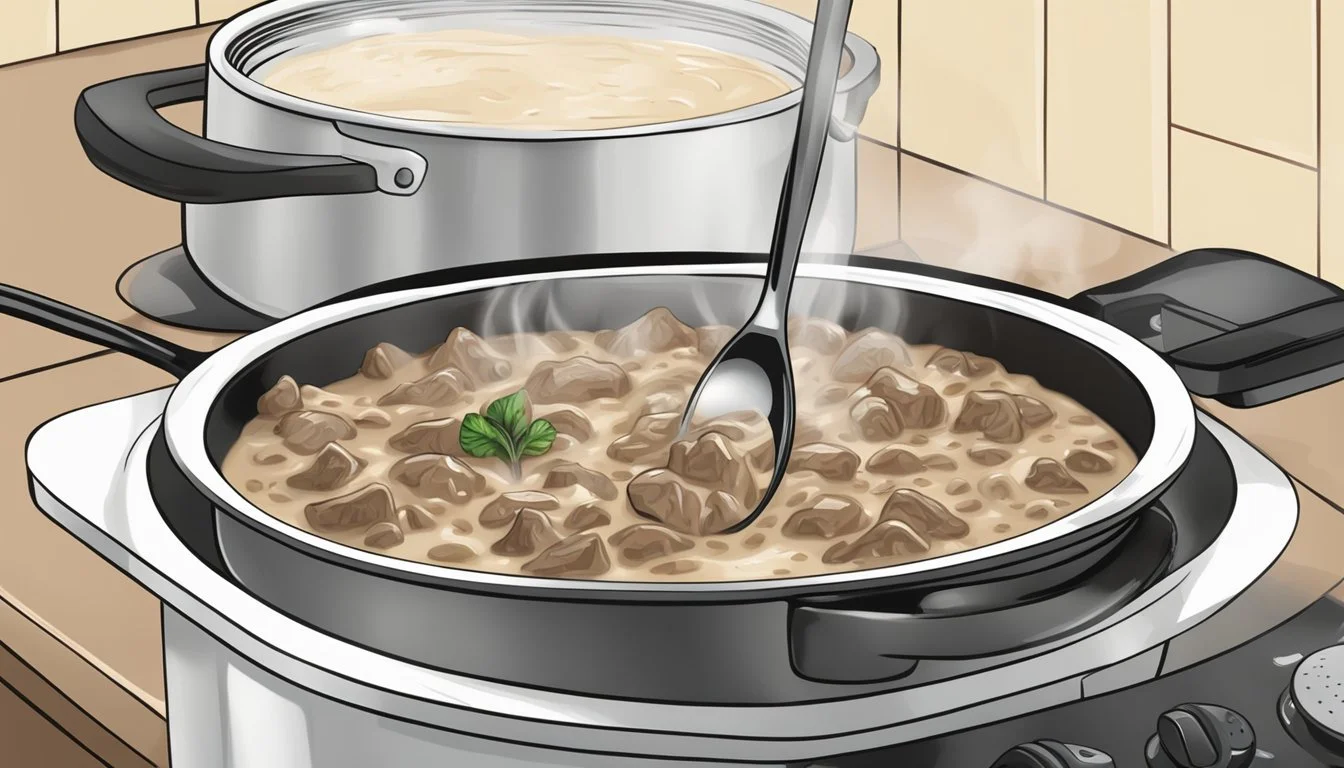How to Reheat Gluten-Free Beef Stroganoff
Best Methods and Tips
Gluten-free beef stroganoff is a comforting and delicious dish, but reheating it can sometimes be a challenge, especially if you want to maintain its creamy texture and rich flavors. The best method to reheat gluten-free beef stroganoff is using the oven. Place the stroganoff in an oven-safe dish, add a few tablespoons of water, cream, milk, or stock to ensure it stays moist, cover with aluminum foil, and bake at 350°F (180°C) for 10-20 minutes, stirring halfway through.
For those looking for a quicker option, the microwave can also be effective. Transfer the beef stroganoff to a microwave-safe container, cover it loosely with a lid or plastic wrap to prevent splattering, and heat on high in intervals of one to two minutes, stirring well to distribute the heat evenly. This method ensures that your gluten-free stroganoff heats thoroughly without drying out.
Alternatively, reheating in a skillet over medium-low heat with a touch of added liquid can work wonders. This approach not only warms the dish evenly but also helps to revive the flavors, ensuring a delicious meal. Whether using the oven, microwave, or skillet, these methods will help you enjoy every bite of your gluten-free beef stroganoff as if it were freshly made.
Understanding Gluten-Free Beef Stroganoff
Gluten-free beef stroganoff maintains the classic savory flavors while ensuring it is suitable for those with gluten sensitivities. Key elements include gluten-free substitutions and a well-balanced blend of ingredients to maintain its rich taste.
Key Ingredients for Gluten-Free Beef Stroganoff
Quality ingredients are essential. Ribeye or sirloin steak are often used for their tenderness and flavor. Onions and mushrooms add depth. Gluten-free flour or arrowroot starch thickens the sauce.
Beef broth forms the base of the sauce, with sour cream or a dairy-free alternative providing creaminess. Olive oil or another cooking oil is used to sear the meat and sauté the vegetables. Seasonings like salt, pepper, and Dijon mustard enhance the dish.
Substituting Traditional Ingredients for Gluten-Free Alternatives
Traditional flour in the sauce is replaced with gluten-free flour blends or arrowroot starch. This change ensures the sauce has the desired consistency without gluten.
For those who are also dairy-free, coconut cream or dairy-free sour cream can be used instead of traditional sour cream. Ensuring all broth and seasoning mixes are gluten-free is crucial, as hidden gluten can be present in some products. These substitutions maintain the integrity and flavor of the classic beef stroganoff.
Preparing the Beef Stroganoff
Creating a delicious gluten-free beef stroganoff entails careful preparation and attention to detail. From slicing and seasoning the beef to crafting a creamy sauce, each step is essential for a mouthwatering result.
Slicing and Seasoning the Beef
Begin by selecting a tender cut of beef such as sirloin or tenderloin. Slice the meat into thin strips, about a quarter-inch thick, for quick and even cooking.
Season the beef generously with salt and pepper. For added flavor, consider incorporating a pinch of paprika or garlic powder.
In a large skillet, heat olive oil over medium-high heat. Add the sliced beef in batches, making sure not to overcrowd the pan. Cook until browned on all sides, then set aside.
Creating the Creamy Stroganoff Sauce
To make the sauce, start by sautéing finely chopped onions and mushrooms in the same skillet with a bit of olive oil until they are soft and golden. Add garlic during the last minute of cooking.
Sprinkle gluten-free flour over the vegetables and stir to coat them evenly. Gradually whisk in beef broth, ensuring there are no lumps.
Let the mixture come to a bubble, then reduce the heat. Incorporate sour cream, dijon mustard, and a splash of lemon juice for tanginess. Stir until smooth and creamy.
Finally, return the cooked beef to the pan, allowing it to simmer for a few minutes in the sauce until everything is well combined and heated through.
Proper Storage Techniques
Storing your gluten-free beef stroganoff correctly ensures it stays fresh and flavorful. Follow these best practices for refrigerating and freezing.
Refrigerating Your Gluten-Free Beef Stroganoff
To refrigerate gluten-free beef stroganoff, it's essential to cool it completely before storing. Do not refrigerate while hot as this can cause condensation and make the dish soggy.
Place the beef stroganoff into airtight containers to prevent exposure to air, which can dry out the sauce. Label the containers with the date to keep track of its freshness. Typically, refrigerated stroganoff lasts up to 3-4 days in the fridge at a constant temperature of 40°F (4°C).
Storing in several smaller containers instead of one large one can help ensure even cooling and easier reheating.
Freezing and Thawing Guidelines
Freezing extends the shelf life of gluten-free beef stroganoff. Ensure the dish is completely cool before transferring it to freezer-safe, airtight containers. Remove as much air as possible to prevent freezer burn which can affect taste and texture.
Label the containers with the date and contents. Stroganoff can be stored in the freezer for up to 3 months at 0°F (-18°C).
When ready to eat, thaw the stroganoff in the fridge for 24 hours before reheating. Avoid thawing at room temperature to prevent bacteria growth. If you're in a hurry, use the microwave’s defrost setting but proceed immediately to reheating once thawed.
Reheating Procedures
Reheating gluten-free beef stroganoff can be accomplished using a variety of methods, each with specific steps to ensure the dish is heated through without compromising texture or flavor.
Reheating on the Stove
To reheat gluten-free beef stroganoff on the stove, begin by transferring the dish to a skillet. Add a small amount of broth, milk, or cream to maintain moisture. This prevents the sauce from becoming too thick and drying out.
Place the skillet over low to medium heat. Stir the stroganoff occasionally to promote even heating and avoid sticking. It typically takes about 10-15 minutes to reheat, depending on portion size. Ensure the internal temperature reaches 165°F for food safety.
Using the stovetop method allows for control over the reheating process, preserving the creamy consistency.
Using the Microwave Effectively
The microwave is a quick and convenient method to reheat beef stroganoff. Place a portion of the stroganoff in a microwave-safe dish. Add a tablespoon of water, milk, or stock to maintain moisture. Cover the dish with a microwave-safe lid or plastic wrap with a small vent to avoid splatters.
Microwave on medium power for 1-2 minutes. Stir the contents halfway through to distribute the heat evenly. Continue to reheat in short bursts of 30-60 seconds until the dish reaches 165°F. Stir after each burst.
Be cautious of overcooking, as microwaves can dry out the sauce and toughen the meat if not carefully monitored.
Oven Reheating Tips
To reheat in the oven, preheat to 350°F (175°C). Transfer the stroganoff to an oven-safe baking dish. Adding a few tablespoons of broth, milk, or cream helps keep the sauce moist.
Cover the dish with aluminum foil, which prevents drying out. Place the covered dish in the oven and bake for 20-25 minutes. Stir occasionally to ensure even reheating and check the internal temperature.
This method is ideal for larger quantities, providing consistent heating and maintaining the dish's creamy texture.
Accompanying the Stroganoff
To enhance your gluten-free beef stroganoff, consider serving it with complementary sides that highlight its rich flavors and textures. Both gluten-free starches and a variety of vegetables can create a balanced, satisfying meal.
Selecting Gluten-Free Sides
Gluten-free rice makes an excellent side, absorbing the creamy sauce and offering a neutral base. Opt for basmati or jasmine rice for added fragrance. Gluten-free pasta is another favored choice, making sure to pick varieties such as quinoa or brown rice pasta that maintain their texture well.
Mashed potatoes provide a comforting and hearty option. They pair seamlessly with the creamy stroganoff sauce. Use dairy-free or lactose-free butter if needed. Roasted potatoes can add a crispy contrast, fitted for those who enjoy varying textures in their meal.
Vegetable Pairings
Sauteed green beans bring a fresh crunch and vibrant color. Simply sauté them in olive oil with garlic and a pinch of salt. Roasted carrots introduce natural sweetness, making for a delightful accompaniment. Coat them with olive oil and roast until tender.
Steamed broccoli serves as a nutrient-dense option. Steam lightly to retain its pleasant bite. Sautéed mushrooms complement the stroganoff seamlessly, enhancing the dish's mushroom profile.
Including a side of mixed greens salad can also provide a light, refreshing contrast. Drizzle with a simple vinaigrette to offset the stroganoff's richness.
Nutritional Information
Gluten-free beef stroganoff provides a hearty, nutritious meal. It contains a mix of macronutrients and essential vitamins, but it's important to remain mindful of dietary needs and balance.
Balancing Your Meal
Gluten-free beef stroganoff typically delivers a good source of protein and essential nutrients. Each serving often provides around:
Calories: 400-500 kcal
Protein: 25-30 grams
Carbohydrates: 30-40 grams
Fat: 20-25 grams
Fiber: 2-3 grams
This dish combines beef's protein with the richness of the sauce, offering a balanced intake of macronutrients. Adding side vegetables or a salad can boost the fiber and vitamin content, ensuring a well-rounded meal. Adjusting ingredients like cream or butter can also help control fat content.
Dietary Considerations
Those monitoring sodium or cholesterol intake should be cautious. Ingredients such as beef, broth, and cream can contribute significant amounts of saturated fat and sodium. A typical serving can contain:
Saturated Fat: 7-10 grams
Cholesterol: 80-100 milligrams
Sodium: 600-800 milligrams
For a healthier option, consider using low-sodium broth and lean cuts of beef. Using dairy-free alternatives can make the dish suitable for those with lactose intolerance, without compromising on flavor. Monitor sugar closely if any sweeteners or specific sauce variations are used.
Enhancing the Dish
Elevate the flavors and presentation of your gluten-free beef stroganoff with thoughtful garnishing techniques and by adjusting the seasonings to taste. Enhancements can transform leftovers into a meal that feels freshly made.
Garnishing Techniques
Garnishing your beef stroganoff not only makes it visually appealing but also adds complementary flavors. Fresh herbs like parsley can bring a burst of freshness to the dish. Sprinkle chopped parsley over the reheated stroganoff for a bright and earthy contrast.
Adding a dollop of sour cream or a swirl of plain Greek yogurt can create a rich, tangy layer that melds well with the beef and mushrooms. A light dusting of black pepper can add just the right amount of heat to make the flavors pop. For a final touch, consider a sprinkle of grated Parmesan cheese for some extra umami.
Adjusting Seasonings for Taste
Reheating can sometimes dull the flavors of your beef stroganoff, necessitating a tweak in seasoning. Start by tasting the dish and identify what's missing. Often, a pinch of salt can revive the dish's flavor. Don't overlook the role of pepper for a bit of spicy warmth.
If the sauce has thickened too much, stir in a tablespoon or two of beef broth or milk to restore its creamy consistency. For those who enjoy a richer taste, a splash of Worcestershire sauce can add depth. Small adjustments can make a significant difference in bringing your reheated meal to life.
Proper seasoning ensures the beef stroganoff maintains its savory and satisfying qualities, making the meal enjoyable as if freshly prepared.
Special Tips and Tricks
When reheating gluten-free beef stroganoff, it’s essential to retain the tender texture of the beef while ensuring the sauce remains creamy and flavorful. These tips will help make it as easy and comforting as the original dish.
Achieving Perfectly Tender Beef
Preheat Slowly: Reheat the stroganoff at a low temperature, ideally in an oven preheated to 350°F (175°C). This prevents the beef from becoming tough and retains its tender texture.
Moisture Maintenance: Cover the dish with aluminum foil while reheating. This traps moisture, ensuring the beef does not dry out.
Gentle Stirring: Stir gently during reheating to distribute heat evenly without breaking down the tender beef strips. This is crucial for maintaining texture and taste.
Simmering Tips: If using a stove, simmer the beef stroganoff over low heat rather than high to prevent the beef from toughening.
Quick and Easy Preparation Tips
Skillet Reheating: Reheat in a skillet over medium-low heat. This method allows for more control over heat distribution and quicker warm-up times than an oven.
Adding Liquids: Incorporate extra beef broth or water if the sauce appears too thick. Adding small amounts progressively can help reach the desired consistency.
Avoiding Overcooking: Keep a close watch to avoid overcooking, which can alter the flavor and texture of both the beef and the sauce.
Prep Time Efficiency: Use a non-stick pan to speed up clean-up and prevent sticking, allowing for quick reheating without the hassle of stubborn residues.
Common Substitutions and Variations
Adapting gluten-free beef stroganoff to suit different dietary preferences or ingredient availability can be both simple and satisfying. Two of the most frequent modifications involve using dairy-free alternatives and exploring varied meat choices.
Dairy-Free Alternatives
For those who are lactose-intolerant or prefer a dairy-free option, several substitutions can be made without sacrificing flavor. Coconut cream or cashew cream can replace sour cream to maintain the desired creaminess. They provide a rich texture and pair well with gluten-free flour or corn starch to thicken the sauce.
Non-dairy milk like almond milk or soy milk can substitute cow's milk in the mushroom stroganoff. Using olive oil or plant-based butter in place of traditional butter ensures the dish remains dairy-free. These substitutions offer excellent flavor while keeping the dish accessible to more people.
Varied Meat Choices
While traditional beef stroganoff typically uses tender cuts of beef such as sirloin or tenderloin, ground beef can be a convenient substitute. It's easier to cook and often more budget-friendly. Ground turkey or chicken can also be effective, especially for those seeking a lighter protein.
For a more vegetarian-friendly option, mushroom stroganoff is a popular variation. Using hearty mushrooms like portobello or cremini adds a robust meaty texture. Pairing them with gluten-free noodles or rice makes the dish both wholesome and satisfying.
These substitutions and variations ensure that gluten-free beef stroganoff can be enjoyed by anyone, regardless of dietary restrictions or preferences.









